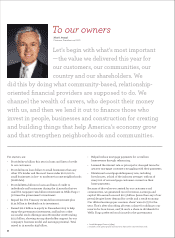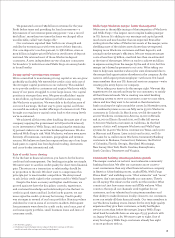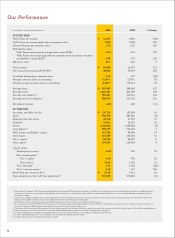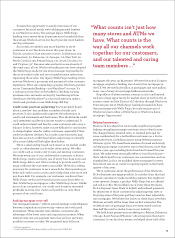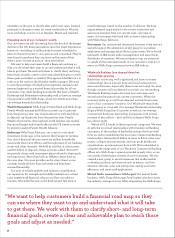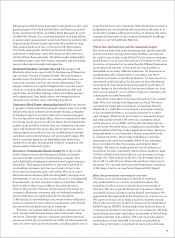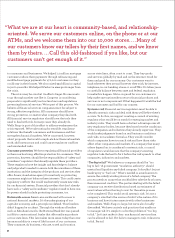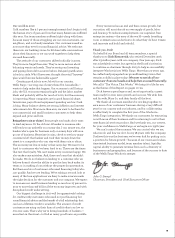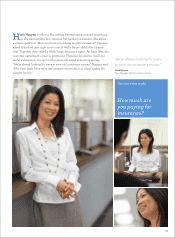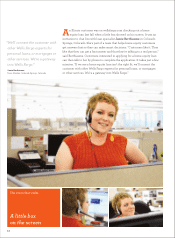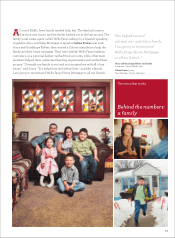Wells Fargo 2009 Annual Report Download - page 5
Download and view the complete annual report
Please find page 5 of the 2009 Wells Fargo annual report below. You can navigate through the pages in the report by either clicking on the pages listed below, or by using the keyword search tool below to find specific information within the annual report.
WellsFargo-Wachovia merger: better than expected
We’re now in the middle innings of the integration of Wachovia
and WellsFargo — the largest, most complex banking merger
in U.S. history. It’s adding to our earnings and capital growth
much more and much earlier than we expected. Even after
writing down the value of Wachovia’s assets at the merger, we’re
shedding more of the riskier assets faster than we expected,
keeping more Wachovia customers and their deposits, and
saving from the merger’s e ciency. We now estimate merger
costs at less than $5billion, one-third less than we estimated
at the time of the merger. We’re on track to achieve $5billion
in expense saving from the merger by the end of 2011, but this
merger isn’t driven by pressure to cut costs. We’re taking our
time to help team members whose jobs were eliminated due to
the merger fi nd opportunities elsewhere in the company. As the
nation’s 12th-largest private employer — with more U.S.-based
team members than any U.S. fi nancial services company — we’re
creating jobs every day in our company.
We’re taking our time to do this merger right. We want this
experience to be smooth and easy for our customers, to satisfy
all their fi nancial needs. We’re creating one retail banking
operating system to serve our customers coast-to-coast when,
where and how they want to be served so their hometown
bank can always be right around the corner. In November 2009,
we combined systems so we can fully serve 95,000 Wachovia
customers in Colorado. In March2010, we did the same for
40,000 Wachovia customers in Arizona, 15,000 in Nevada
and 14,000 in Illinois. By mid-2010, we’ll o er full service
to 600,000 Wachovia customers in California. In the third
quarter of 2010, we’ll integrate Wachovia and WellsFargo
systems for 514,000 Wachovia customers in Texas, and 21,000
in Missouri and Kansas. Later in 2010 and in 2011, we’ll do
the same for 14million more Wachovia Community Banking
customers in Alabama, Connecticut, Delaware, the District
of Columbia, Florida, Georgia, Maryland, Mississippi,
NewJersey, NewYork, NorthCarolina, Pennsylvania,
South Carolina, Tennessee and Virginia.
Community Banking: investing in future growth
The merger created our nation’s most extensive community
banking franchise. We o er our customers more coast-to-
coast convenience than any other fi nancial services company
in America: 6,629 banking stores, 12,363 ATMs, WellsFargo
Phone BankSM and wellsfargo.com. “Most extensive” and “more,”
however, don’t automatically benefi t our customers. There’s
an old saying: The value’s in the worth, not the number. What
counts isn’t just how many stores and ATMs we have. What
counts is the way all our channels work together for our
customers, and our talented and caring team members and
their ability to make decisions locally, closest to our customers,
so we can satisfy all their fi nancial needs. Our team members in
our Wachovia banking stores, known for the very high-quality
experience they give their customers, actually had higher
service scores than before the merger. Legacy WellsFargo
retail bank households have an average of 5.95 products with
us; legacy Wachovia, 4.65. We want to get to eight. One of
every four legacy WellsFargo customers already has eight
or more products with us.
1 See footnote 4, page 4.
2 Checking accounts that pay interest, deposits that don’t, savings certifi cates,
market rate and other savings, and some foreign deposits
We generated a record $89billion in revenue for the year.
Profi t before taxes and providing for loan loss reserves — a
key measure of our revenue-generating power — was a record
$40billion1, more than two times the loans we charged o as
uncollectable, called “net charge-o s.”
Our customers signaled their faith in our strength and
stability by entrusting us with even more of their deposits.
Our core deposits2 rose fi ve percent, to $781billion, even as
$109billion in higher-priced Wachovia certifi cates of deposit
matured. We retained most of those Wachovia deposit
customers. A new, independent survey of 33,500 consumers
for brands in 71 industries rated Wells Fargo #1 among banks
in brand loyalty.
Strong capital — growing even stronger
We’re committed to maintaining strong capital so we can grow
profi tably and safely. We entered the credit crisis with one of
the strongest capital positions in our industry. This enabled
us to provide credit to customers and acquire Wachovia while
many of our peers struggled to cover large losses. Our capital
position is stronger than ever. We grew stockholders’ equity
to $112 billion, up from $47 billion just before announcing
the Wachovia acquisition. We were able to do this because of
our record earnings, the best way to grow capital, and three
successful secondary market o erings of common stock. This
brought our regulatory capital ratios back to the strong levels
we’ve maintained.
We achieved all this even after doubling the asset size of our
company, repaying the government in full (and with interest)
on its investment in Wells Fargo, and acquiring the remaining
23 percent stake in our securities brokerage business. We also
reduced Wells Fargo’s risk. With Wachovia, we have even more
diversity of businesses, customers, geographies and revenue
sources. We believe we have less exposure than any of our large
bank peers to capital loss from high-risk trading, derivatives
and cross-border international risk.
Rate of credit losses slowing
To be the best in fi nancial services, you have to be the best in
credit and risk management. Our lending principles are simple.
We never want to sacrifi ce credit quality for short-term fi nancial
gain. The return on a transaction or relationship should be
in proportion to the risk. We don’t want to compromise this
principle just to meet market competition. We always need
to ask: Is this credit right for the customer and for WellsFargo?
Despite the down economy and higher credit losses, we
proved again we have the discipline, controls, experience,
and customer knowledge and relationships to be the best in
credit in good times and bad. In the fourth quarter, we saw
more signs the credit cycle may be turning. Credit quality
was stronger in several of our loan portfolios. Housing values
stabilized or rose in some of our metro markets. Delinquent
loan payments were down for credit cards, auto loans, part of
our home equity portfolio, small business loans and lines of
consumer credit.




